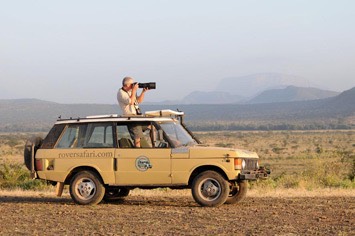
For four weeks we travelled through Kenya in a classic Range Rover on a self-drive camping safari. We camped in some spectacular National Parks and Reserves and took thousands of photos. What follows is the driver's tale of this adventure, a more detailed diary with additional photos was kept by the passenger!
Travelling overland through Africa is the cherished ambition of many 4WD enthusiasts, but few can afford the time necessary to undertake a full blown expedition. One way to satisfy the craving for an off-road adventure in wildest Africa is to fly out and hire a car for a self-drive safari holiday. Finding an unexpected opportunity to take four weeks off, Maren and I did just that, flying down to Nairobi at the beginning of December 2008 for a camping tour through some of Kenya’s finest National Parks and Reserves.
Car hire is easily arranged in Kenya, but we also wanted to hire a comprehensive set of camping equipment, preferably from the same firm, which narrowed the choice somewhat. Based on my previous African travel experiences, I had a preference for an older car. Turning up in remote corners of Africa in a shiny new 4WD is one of the best ways of attracting the wrong sort of attention. So after trawling the Internet we finally decided on Erikson Rover Safaris (www.roversafari.com), who have a small fleet of elderly Range Rovers and a Land Rover for hire.
Our car was a 1981 two-door Range Rover, powered by its original V8 petrol engine through a four-speed gearbox. I lost count of the number of times I tried to change up into fifth gear! We arranged to be met with the car on our arrival at JK Airport in Nairobi where the delivery driver led me under the bonnet and pointed out a spare coil, and on the dashboard a switch to activate a second fuel pump should the engine seem starved. I must admit to feeling shocked when I saw how heavily loaded the car was, even before we attempted to fit ourselves and our bags in. The back was crammed full with tents, bedding, table, chairs, kitchen equipment and jerry cans, leaving only the front two seats free. The car sloped back on its hind quarters like a well-fed hyena and I feared the worst as we wondered how on earth we could squeeze in our two bags plus our two rucksacks bulging with cameras and telephoto lenses.
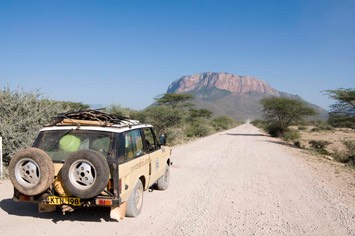
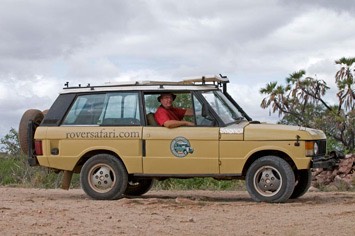
At this stage I should admit to our one concession to luxury for the trip: the package we hired included a cook to accompany us for the duration. The decision to take a cook turned out to be a great success. Not only was Charles an expert field cook who constantly astounded us with his culinary expertise by serving up delicious home-made soups, samosas, pizzas and even baked bread in an improvised oven, but we also had the benefit of someone to guard the camp from marauding baboons and vervet monkeys while we were out driving. He was a great help shopping too; his presence often helped ensure we paid the local rate rather than the special price for tourists!
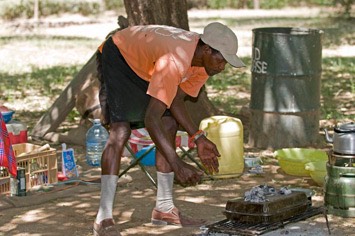

Standing in the airport car park it seemed impossible that we could even fit our bags in the tightly packed car, let alone our cook. Oh, and I forgot to mention, the driver needed a lift home too. But incredibly we somehow managed to get all on board with the two guys squeezed into a narrow slot on the back seat, sandwiched between cool boxes and our bags. So off we set for Nakuru, where our first nights would be spent at the Makalia Falls camp site in the National Park.
The car coped surprisingly well with its heavy load, although it seemed prudent to keep our speed low on the busy highway between Nairobi and Nakuru. Accident rates are alarmingly high throughout Africa and it is always important to drive carefully and defensively. Caution seemed especially relevant during this first leg in an unfamiliar car, but at least we could enjoy some of the breath-taking views of the Rift Valley as we drove down the escarpment overlooking Hell’s Gate and Naivasha.
Once we had off-loaded and set up camp, the car was at last liberated and we could leave Charles to work his magic in the kitchen while we enjoyed our first game drive. The pattern we settled into for the whole safari was to get up at 5:30 for an early breakfast, then set off at sunrise for a morning game drive, returning to camp around mid-day or so for a light lunch. We took a short siesta during the hottest part of the day and our daily shower after that. All but one of the campsites we stayed at had basic shower facilities and the cold water was a lot more agreeable at this time of day than first thing in the morning. After a fortifying cup of Kenyan coffee we set off again for an evening game drive at about 4 pm, returning just before the mandatory ban on night driving in National Parks and Reserves came into effect at 7 pm.
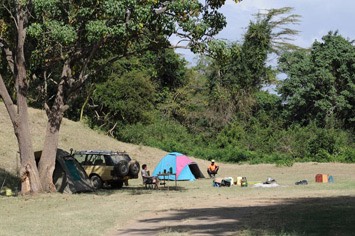
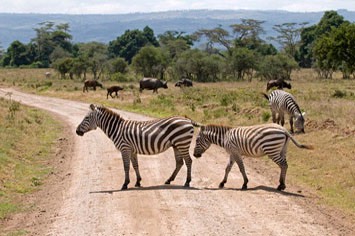
The roads in Nakuru NP are not especially challenging, particularly the main circuits around the spectacular lake which are all easily negotiable by the ubiquitous Nissan and Toyota minivans that hurry tourists between views of grazing white rhinos, large herds of buffalo and the massed ranks of flamingos and pelicans.
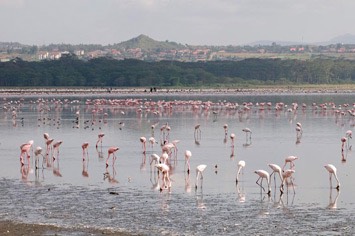

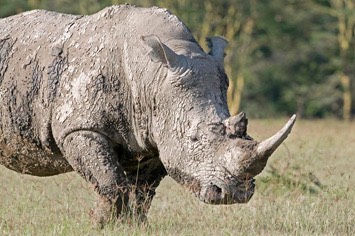
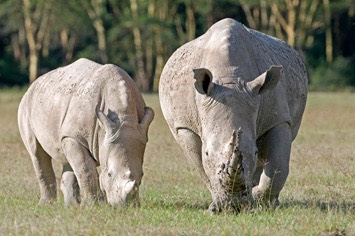
Exploring some of the lesser used tracks that climb the hills flanking both the east and west sides of the lake however, we soon found some more interesting conditions on which to test the car’s capabilities. Steep gradients on loose stones and tracks deeply incised by water runnels provided some good practice and a chance to get a feel for how the car handled on more demanding surfaces. Some of the steeper slopes, both up and down, called for bottom gear, but the car proved satisfyingly flexible and capable in second gear. We now felt ready to move on to the next stage of our safari and drive north to Samburu.
For the most part, the drive from Nakuru to Samburu was on tarmac, but we left that behind near Isiolo. That’s not to say that the going was smooth as many sections of sealed road were badly pot-holed. The main hazard was oncoming traffic weaving from one side of the road to the other in an effort to avoid the holes. The worst offenders were large army trucks heading south from the ranges in Samburu district, whose drivers seemed particularly careless of other vehicles in their path. On one occasion I was forced to steer the car right off the road as a huge green army truck veered over towards us. There was no verge and I was suddenly faced with a deeply rutted slope into a ditch. A lesser car could well have come to grief, but, despite our heavy load, the old Rangie wallowed in and out of the ruts without any danger of grounding or rolling as I slowed her to a halt. But it was a lesson learned and I took care to look well ahead for approaching convoys of military vehicles and stay well out of their way.
Isiolo is a bustling little town, its population recently inflated with Somalis escaping their troubled homeland, and we made slow progress through its busy main street lined with market stalls and thronged with ever hopeful hawkers of fruit, hats, shoes and trinkets. The drive from there to Archer’s Post, where the main gate into the Samburu National Reserve is located, was extremely dusty. A new road is under construction and we drove on a seemingly endless diversion alongside the road works, gazing enviously at the pristine surface of the new road. Some eight hours after breaking camp in Nakuru we finally arrived at our destination and set up camp under the shade of tall trees on the banks of the Ewaso Ngiro river.
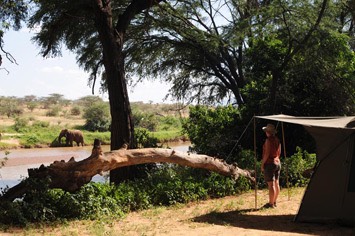
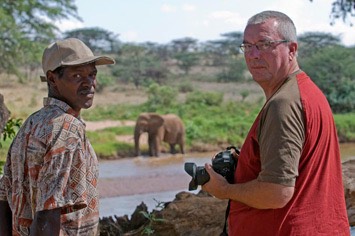
Of all the National Parks and Reserves I have visited in Kenya, Samburu remains my favourite. Its scenery of hills, rocky outcrops, plains and river hold a fascinating variety of habitats, the predominant dry bush vegetation is rarely too dense so that its abundant animal life is easily seen, and the colourful Samburu people seem to be among the continent’s friendliest, happiest folk. It’s a driver’s paradise too as there is a very comprehensive network of tracks making almost the entire reserve accessible. In fact the entrance fee includes the adjacent Buffalo Springs NR, separated from Samburu NR by the Ewaso Ngiro river, and Shaba NR on the other side of Archer’s Post. There are no fords through the brown water of the river, which must be crossed by a bridge not far from the public campsite, so we had the choice of exploring either Samburu or Buffalo Springs on each game drive. For the more adventurous driver there are dry rivers with rocky approaches and sandy beds, as well as steep sided stream gulleys to give a real feeling of off-road driving in truly wild country, although of course it is important to stay on existing tracks in order not to damage this precious environment. That never felt like a limitation as visitor numbers were low and the few vehicles we came across tended to stick to the main tracks where they could most easily find the animals they had come to see. We frequently drove for hours without encountering a single vehicle and many of the small tracks we followed showed very little sign of recent use.

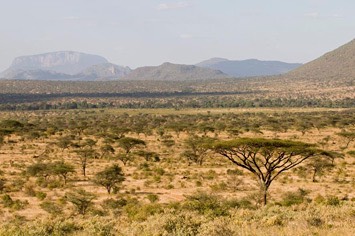
Our main interest in Samburu was its elephant population. Elephants are intelligent social animals and their attitude towards humans is largely shaped by their experience of human attitudes towards themselves. So in areas where there has been a recent history of poaching or conflict between elephants and farmers for example, the elephants can be wary and intolerant of approach. But here in Samburu, elephants and people have been peacefully coexisting for many years and the animals have become as friendly and approachable as any wild population of African elephants can be. Nevertheless, they are big strong animals capable of causing severe injury to cars and occupants if riled and they deserve to be approached with respect and caution.
We had some magical encounters with the elephants of Samburu. The first started when we spotted a group of elephants moving purposefully through the bush. The excellent network of tracks allowed us to manoeuvre into position several hundred metres ahead of the animals, turn the engine off and emerge through the roof hatch to wait quietly for their approach. With a mixture of delight and apprehension we soon noticed that they were walking towards us down the very same track we were stopped on. But the elephants remained calm and showed neither hesitation nor annoyance at our presence as they came ever closer. When only a few metres away, the stately procession divided and the now alarmingly huge animals plodded silently past on both sides of the car, almost within touching distance. We were awe-struck, but despite the adrenaline inducing sensation of being closely surrounded by these powerful wild animals, we never felt any sense of threat.
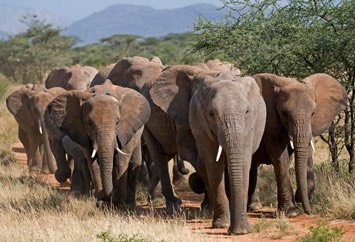
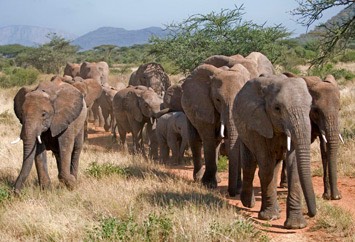
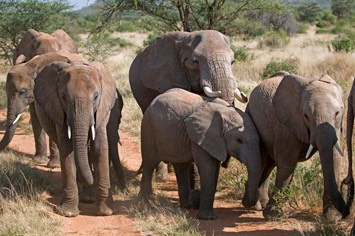
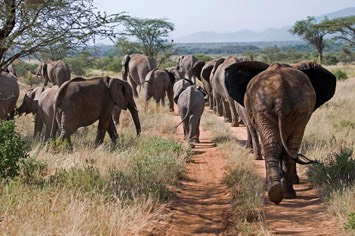
After four full days in Samburu it was time to move on. Our next destination was Lake Baringo with the prospect of an interesting drive through the hill country of northern Samburu district to get there. Our route took us past the sacred mountain Ol Olokwe where we branched left off the main road to Marsabit and Ethiopia. Splendid views of the Ewaso Ngiro flowing through deep cut valleys appeared as we neared the highest point of our route and later, as we descended towards the Rift Valley, a distant view of Lake Baringo opened up. The road was unsurfaced but in good condition, except for one short section that had been surfaced with tarmac many decades ago and is now an ugly lacework of narrow crumbling ridges separating deep potholes.
We arrived at the Roberts’ camp site for a couple of days relaxation and pitched our camp under the shade of trees a stone’s throw from the shoreline of Lake Baringo. I first camped here in 1990 when the large camp site was busy with overlanders and independent travellers who had hired cars in Nairobi. My next visit was in 2000 when I was dismayed to see that the lake shore had receded by something like 100 metres and there was only one other camper, a lone German in a large truck. This time it was gratifying to see that water levels had risen again, although to such an extent that the shoreline had now encroached well into the camp site. We had arrived on a weekend and there were a few campers taking a break from work in Nairobi, but by Sunday afternoon all had returned to the city. A German family in a Land Rover turned up (we had met them a few days earlier in Samburu where they told us of their drive down from Europe), but otherwise we were alone with the birds, crocs and hippos. The low level of tourism is bad news for both the Kenyan economy and the conservation of its outstanding wildlife, both of which depend largely on visitors from abroad. This means there has rarely been a better time to visit Kenya, both in terms of the contribution you can make by spending your hard-earned cash there, and by enjoying the beauty of its wild places with relatively few other tourists cluttering up the view. One can only hope that, like the water level in the lake, visitors will return once again to sustain the country and its wildlife.
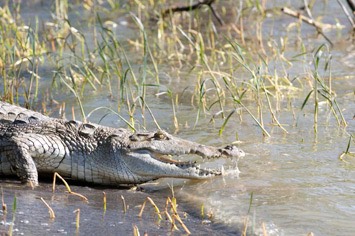
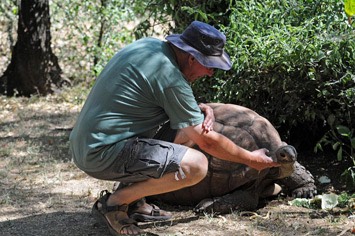
With the first part of our safari now done, we headed back to Nakuru to restock our provisions and prepare for what is often referred to as the jewel in the crown of Kenya’s wild places, the Masai Mara. Erikson Rover Safaris are based in Nakuru where they have a guest house, so we were able to stay there for the night and get an early start the next day, without having to pack the camp up and load it all into the car.
The road down to the Mara was straightforward, but as we approached the reserve we turned off onto a maze of rough tracks that would lead us around the perimeter to the Talek gate, where privately run campsites on the banks of the Talek River lay just outside the boundary of the reserve. Once again the low level of visitor numbers was very apparent and we were able to enjoy a whole campsite enclosure to ourselves.
The Masai Mara is part of a vast area of gently rolling plains extending north from the Serengeti in Tanzania. Rivers dissect the plains, forming barriers to animals and cars alike, although there are crossing places for both. We were not there for the annual migration of the wildebeest, when countless thousands of animals pour through the narrow crossings, attracting the predatory attention of crocodiles and big cats, but we faced our own river crossing challenges negotiating the Talek River. Much of the best animal action was to be found in the west of the reserve, some 30 km from our camp site, so we had long drives to get there and back each day, crossing the river at three or four different places. Crocs and hippos abound, so this is no place to get stuck, and their presence certainly concentrates the mind when the time comes to let in the clutch and go for it.
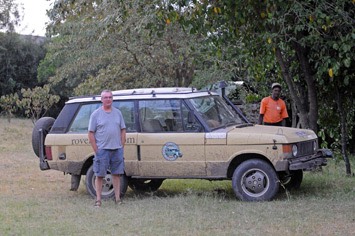
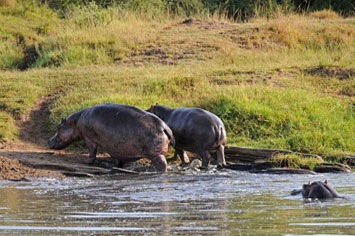
One crossing of the Talek River did give us a nasty surprise. The track we were on dipped down to the river and emerged on the far bank, and tyre tracks indicated that it had been used in the not too distant past. The river bed was formed by smooth, flat slabs of rock like some casually thrown together crazy paving, with water trickling through the variably sized gaps between slabs. It looked pretty straightforward and I picked my route rather too casually, engaged first gear and rolled forwards. Hippos with just their eyes and noses showing gazed at us from a deeper pool a few metres downstream. What I had failed to notice was that some of the apparently innocent gaps between slabs were in fact deep holes. Suddenly a rear wheel dropped into a black hole and there was a juddering bang as the tow hitch dropped onto solid rock. For a brief instant I had a vision of the car hanging there, wheels spinning uselessly in empty space, but thankfully we kept moving forwards and with a few unseemly rolling lurches the car pulled itself out of the hole and up the steep bank on the far side.
We were particularly keen to see cheetahs here in the Mara and as luck would have it, we had some spectacular views of these elegant big cats, although I have to admit that we cheated a little when it came to locating them. Scanning the landscape from a vantage point, we noticed a green Discovery with a small side awning, surely a camera car like those used to film the Big Cat Diary, and there nearby was a cheetah with three cubs. We closed slowly in, taking care not to drive into camera shot and switched off the engine to watch. Cheetahs typically sit on raised platforms from which they can survey their surroundings and this family group was sat atop an old termite mound surrounded by long grass. As we sat admiring them, a lioness appeared from the far side of the long grass, heading straight for the cheetahs. This was potentially an extremely dangerous situation for the young cheetahs, as lions will not tolerate other predators in their territories and are likely to pursue and kill cheetah cubs. But our cheetah knew exactly how to handle the situation. As the lion approached, a signal from mum sent the cubs off the mound into the cover of the long grass. The cheetah then dropped down into the grass herself, headed across the path of the lion and popped up in front of it provocatively, taunting the lion which gave chase with leaping bounds through the rank grass. Of course the lithe cheetah easily outran the heavyweight lion, which was left panting and confused in the long grass as one by one the family emerged from cover and regrouped. As the Discovery moved off to get a better angle on the bewildered lion, we saw that it was indeed driven by Simon King, filming a feature film version of the Big Cat series for Disney.
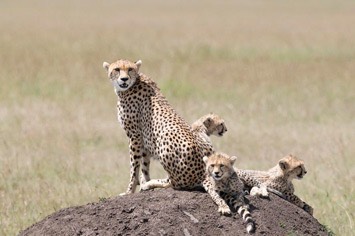
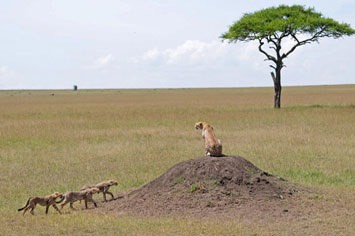
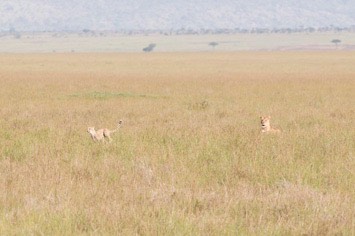
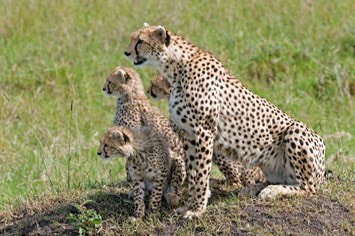
While turning the car to move on ourselves, there was an ominous hissing sound from a rear wheel. We had a puncture. The tyre was already completely flat and a short distance away a hungry lioness was on the prowl. Great! Posting Maren on lion watch, I got the high-lift jack out and changed the wheel in record time.
We caught up with Simon King later in the day, still filming the same cheetah family. This time her eyes were fixed on a Thomson’s gazelle and we watched enthralled as she stalked slowly forward, then suddenly broke cover and sprinted into a spectacular chase, dust flying as the terrified gazelle tried turning to evade capture, only to be brought down and quickly killed by the stunningly agile cat. Apparently this was her first kill in three days, so it was vital that she and her three cubs fed well from the kill. But just as they were about to tuck in, a herd of cattle approached and the ever cautious mum drew her cubs away. Cattle grazing is not permitted in the reserve and Simon King was understandably furious that this illicit herd was endangering the survival of the cheetah family. He stopped filming, headed up to the cattle and by driving back and forth in front of the advancing beasts, used his Discovery to herd the animals away.
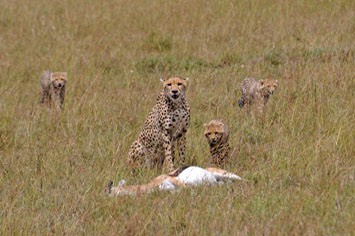
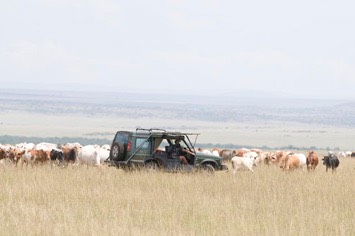
After our big cat experiences in the Mara it was time to move on again, this time to Amboseli, a relatively small National Park overlooked by the dramatic peak of Kilimanjaro. In fact the mountain rarely appeared through its veil of cloud during our stay and the predominant impression we were left with was of all-pervading dust. Amboseli has water and areas of swamp in an otherwise arid landscape, so wild animals and domestic livestock concentrate in the area, putting undue pressure on the fragile vegetation surrounding the wet areas. The result is something approaching dust-bowl conditions and, to avoid making matters worse, driving off the designated tracks is strictly forbidden. One day was enough for us in this degraded environment, particularly as the water supply to the camp site had failed, so we set off to Tsavo East, the largest National Park in Kenya.
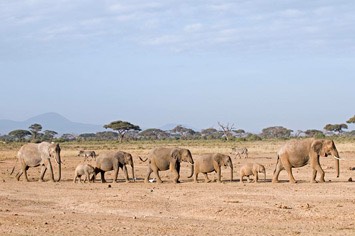
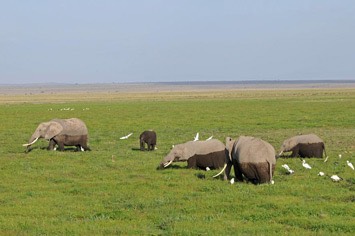
Tsavo became infamous when lions killed a total of 130 construction workers building the railway line between Mombasa and Nairobi. Despite the passing of time their reputation survives and Charles our cook was a little apprehensive about the prospect of being left alone in camp all day with descendents of the feared man-eaters of Tsavo at large. Although we did see lions, our main interest was focussed once again on elephants, in this case because of their extraordinary red colour brought about by their habit of plastering themselves in mud and dust, which here in Tsavo East is a rich red colour.
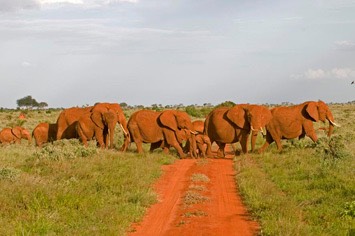
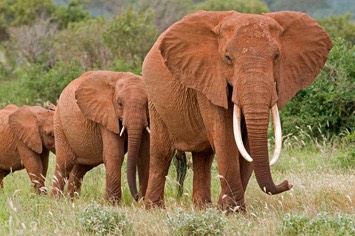
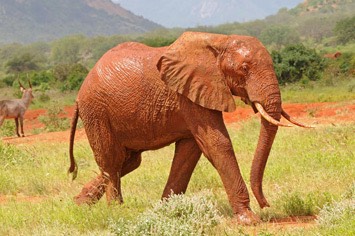
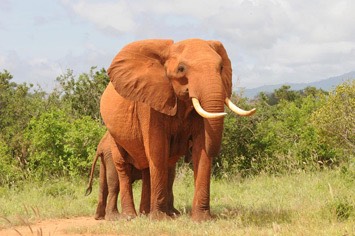
Our camp was located near the seasonal Voi river which, with its associated Kanderi swamps, was only passable in a few places. Navigation in the park was easy, thanks to the numbered signs at all main junctions which correspond to numbers marked on the park map. One afternoon we consulted the map and planned a long drive that would take us across the Voi, through an area of plains in a big loop, then back to cross the drier end of the swamp system. The Voi crossing near the beginning of our drive led through a patch of soft sand, some gullies and a rather alarmingly deep hole on one side of a narrow track that had the car leaning over at a perilous angle. But the old Rangie coped superbly well and we set off on our long circuit, pausing to photograph several large groups of bright red elephants. When finally we arrived back at the Kanderi swamp at 6 pm, our hearts sank as we saw the track simply vanish into tall, lush green grass. The map showed the track crossing the swamp with no indication of it being only seasonally passable, but clearly nobody had driven through here for some time. Given that the surrounding bushy habitat was more than likely infested with lions, walking ahead to test the firmness of the ground was out of the question. Dry land on the far side was tantalisingly close, perhaps only 250 m away, but could we risk an attempt at crossing? The prospect of turning around and retracing our steps seemed equally daunting at this time of the evening, as the 40 kph speed limit in all National Parks would mean it would almost certainly be dark by the time we reached our camp, and probably also at the tricky Voi crossing.
After a brief discussion I thought we should probe ahead slowly in the car to see what the going was like. I drove the car gingerly into the long grass, aiming for the point on the far side where the track once more emerged. Only 20 to 30 m in a rear wheel broke through the matted vegetation and span in sticky brown mud. We were stuck. The instant it happened I depressed the clutch and took the car out of gear to assess the situation. It wasn’t bad at all; but this was neither the time nor place to make any further mistakes, we had to come out clean at the first attempt. I had seen a litter of sticks on the ground just before we entered the tall grass and I considered walking back to gather some to put under the wheel, but one glance at the line of bushes raised the spectre of the man-eaters and I quickly changed my mind. The car’s kit included a small spade so I dug out the mud behind the offending wheel, although the tough rhizomes of the grass made this hard work. Starting the engine up again, I gently rocked the car back and forth by pumping my foot on and off the clutch in reverse gear, gradually building up momentum each time until the car popped out of its hole, and then I gunned it back to the hard, dry track. Phew! The drive back went quicker than expected, this time we stopped for no elephants and only a large monitor lizard in the track interrupted our progress. We traversed the deep hole and soft sand at dusk at just made it into camp as darkness fell.
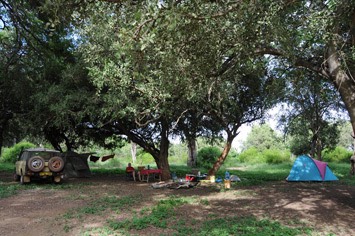
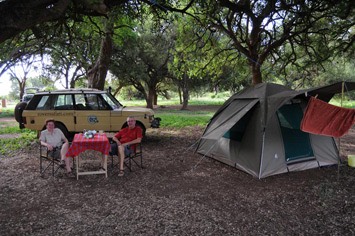
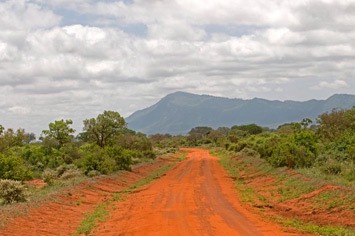
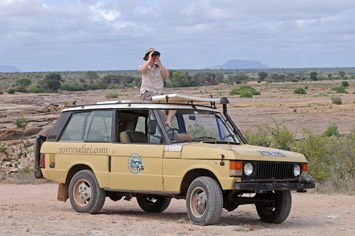
We spent Christmas exploring Tsavo East but all too soon it was time to move on to the last camp of our safari in Tsavo West. Despite its close proximity, Tsavo West is quite different in character to Tsavo East. Dense bush makes it extremely difficult to view its doubtless abundant wildlife. The scenery is wonderful, thanks to the surrounding hills, but it lacks the open vistas with abundant animal life of its eastern counterpart. The tracks were all in good condition making driving relatively uneventful with the exception of some sections passing through ancient lava flows where the tracks were littered with melon-sized lumps of black lava.
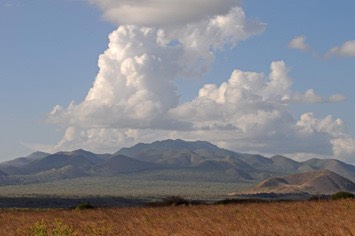
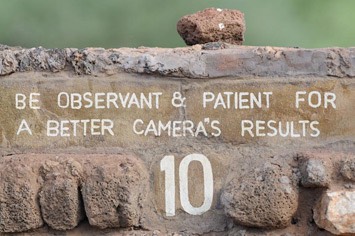
After two nights in Tsavo West we packed the camp up for the last time and prepared to wend our way back to Nairobi. There is a camp site near Nairobi National Park’s Langata gate (Nairobi Park Services) but they also have some affordable rooms, so we took the easy option and left the camping gear in the car. On our last day we spent the morning in Nairobi National Park, which really is worth a visit. In fact there we saw the only black rhinos of our safari. We said farewell to Kenya’s elephants at the David Sheldrick Wildlife Trust (www.sheldrickwildlifetrust.org), where they raise orphaned elephants and rhinos, then headed for the Macushla House (www.macushla.biz) in Karen, where we had arranged to have the car picked up and spend our last night in luxury.
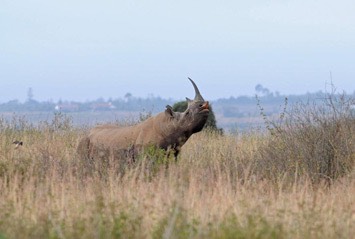
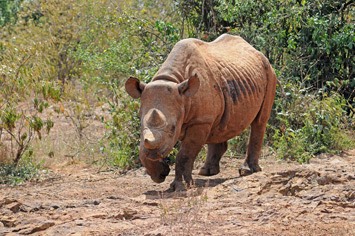
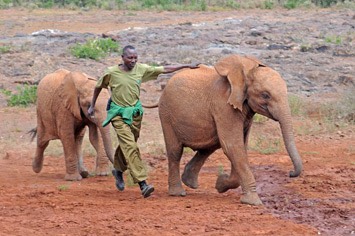
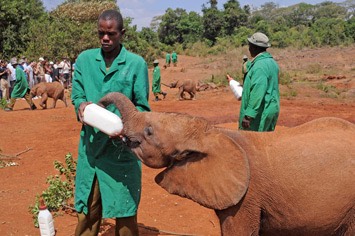
We left Kenya feeling very satisfied by a successful safari. Driving such an old car in Africa adds to the sense of adventure, but the old Rangie never seriously let us down. We had a few punctures and the car was a little reluctant to start on some mornings, but I cured that by fitting a new coil. We had the reassuring knowledge that, if anything had gone seriously wrong with the car, the hire company would send a mechanic out straight away, but that was never necessary. On more than one occasion our grotesquely laden car was admired as we pulled into filling stations and greeted with the adage “what’s old is gold”. Its true that older cars often prove more reliable in the bush as they tend to be simpler and predate the introduction of electronic control systems in more modern models. But maybe next time we’ll find the time to drive down in our own car…